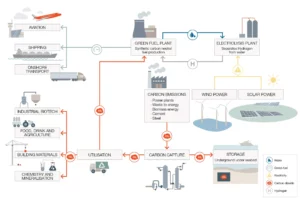Carbon Capture Utilisation and Storage (CCUS)
#GS-03 Climate Change
For Prelims
What is CCUS:
- Carbon capture, utilization, and storage (CCUS) is the process of capturing carbon dioxide emissions and either using them to make things such as building materials (utilization) or permanently storing them thousands of feet below the surface (storage).
- CCUS helps reduce the carbon intensity of industrial operations and is a critical component of meeting the global net-zero ambitions of the Paris Agreement.
- Carbon dioxide storage in geologic formations includes oil and gas reservoirs, unmineable coal seams and deep saline reservoirs.
- CCUS technology would help in promoting the low carbon-hydrogen economy and in removal of the CO2 stock from the atmosphere.
- CCUS has an important and critical role to play in India to accomplish net-zero by 2070.
- CCUS could enable the production of clean products while utilising rich endowments of coal, reducing imports and thus leading to a self–reliant India economy.
For Mains:
The need of CCUS Technology:
- Despite the adoption of alternative energy sources and energy efficient systems to reduce the rate of CO2 emissions, the cumulative amount of CO2 in the atmosphere needs to be reduced to limit the detrimental impacts of climate change.
- Efforts to limit rising atmospheric CO2 concentrations while meeting increasing global energy demand, can only be achieved by deploying a comprehensive portfolio of technologies that include alternative energy sources, energy efficient systems, and carbon capture, utilization and storage (CCUS) measures.
The concerns of CCUS:
- CCUS involves multiple aspects that need to be in sync for the successful removal or capture of CO2 from the flue gas or the atmosphere, followed by utilization and storage.
- Carbon capture involves the development of sorbents that can effectively bind to the CO2 present in flue gas or the atmosphere, which is expensive.
- In addition, there has been a considerable debate about the fate of the captured and compressed CO2.
- Ideally, converting CO2 into useful chemicals of commercial importance, or utilizing CO2 for oil extraction or remediation of alkaline industrial wastes, would add economic value to this greenhouse gas.
- However, the demand for CO2 is limited compared to the vast amount of CO2 that needs to be removed from the atmosphere, to reduce the detrimental environmental impacts of climate change.
Source “NITI Aayog proposes decarbonising of industrial emissions“





